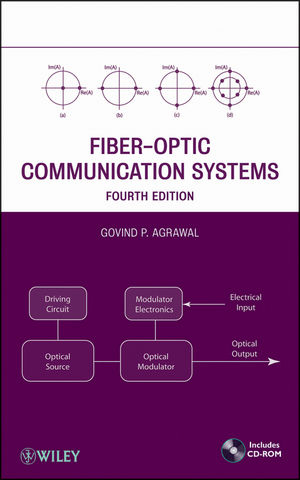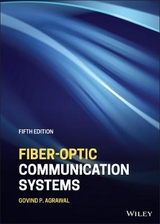
Fiber–Optic Communication Systems
John Wiley & Sons Inc (Verlag)
978-0-470-50511-3 (ISBN)
- Titel erscheint in neuer Auflage
- Artikel merken
Govind P. Agrawal is a professor at the Institute of Optics at the University of Rochester and a Fellow of both the Optical Society of America and the Institute of Electrical and Electronics Engineering. He is also a Senior Scientist at the Laboratory for Laser Energetics. Dr. Agrawal is author or coauthor of more than 300 research papers, book chapters, and monographs.
Preface. 1 Introduction. 1.1 Historical Perspective. 1.2 Basic Concepts. 1.3 Optical Communication Systems. 1.4 Lightwave System Components. Problems. References. 2 Optical Fibers. 2.1 Geometrical-Optics Description. 2.2 Wave Propagation. 2.3 Dispersion in Single-Mode Fibers. 2.4 Dispersion-Induced Limitations. 2.5 Fiber Losses. 2.6 Nonlinear Optical Effects. 2.7 Fiber Design and Fabrication. Problems. References. 3 Optical Transmitters. 3.1 Semiconductor Laser Physics. 3.2 Single-Mode Semiconductor Lasers. 3.3 Laser Characteristics. 3.4 Optical Signal Generation. 3.5 Light-Emitting Diodes. 3.6 Transmitter Design. Problems. References. 4 Optical Receivers. 4.1 Basic Concepts. 4.2 Common Photodetectors. 4.3 Receiver Design. 4.4 Receiver Noise. 4.5 Coherent Detection. 4.6 Receiver Sensitivity. 4.7 Sensitivity Degradation. 4.8 Receiver Performance. Problems. References. 5 Lightwave Systems. 5.1 System Architectures. 5.2 Design Guidelines. 5.3 Long-Haul Systems. 5.4 Sources of Power Penalty. 5.5 Forward Error Correction. 5.6 Computer-Aided Design. Problems. References. 6 Multichannel Systems. 6.1 WDM Lightwave Systems. 6.2 WDM Components. 6.3 System Performance Issues. 6.4 Time-Division Multiplexing. 6.5 Subcarrier Multiplexing. 6.6 Code-Division Multiplexing. Problems. References. 7 Loss Management. 7.1 Compensation of Fiber Losses. 7.2 Erbium-Doped Fiber Amplifiers. 7.3 Raman Amplifiers. 7.4 Optical Signal-To-Noise Ratio. 7.5 Electrical Signal-To-Noise Ratio. 7.6 Receiver Sensitivity and Q Factor. 7.7 Role of Dispersive and Nonlinear Effects. 7.8 Periodically Amplified Lightwave Systems. Problems. References. 8 Dispersion Management. 8.1 Dispersion Problem and Its Solution. 8.2 Dispersion-Compensating Fibers. 8.3 Fiber Bragg Gratings. 8.4 Dispersion-Equalizing Filters. 8.5 Optical Phase Conjugation. 8.6 Channels at High Bit Rates. 8.7 Electronic Dispersion Compensation. Problems. References. 9 Control of Nonlinear Effects. 9.1 Impact of Fiber Nonlinearity. 9.2 Solitons in Optical Fibers. 9.3 Dispersion-Managed Solitons. 9.4 Pseudo-linear Lightwave Systems. 9.5 Control of Intrachannel Nonlinear Effects. Problems. References. 10 Advanced Lightwave Systems. 10.1 Advanced Modulation Formats. 10.2 Demodulation Schemes. 10.3 Shot Noise and Bit-Error Rate. 10.4 Sensitivity Degradation Mechanisms. 10.5 Impact of Nonlinear Effects. 10.6 Recent Progress. 10.7 Ultimate Channel Capacity. Problems. References. 11 Optical Signal Processing. 11.1 Nonlinear Techniques and Devices. 11.2 All-Optical Flip-Flops. 11.3 Wavelength Converters. 11.4 Ultrafast Optical Switching. 11.5 Optical Regenerators. Problems. References. A System of Units. B Acronyms. C General Formula for Pulse Broadening. D Software Package.
| Reihe/Serie | Wiley Series in Microwave and Optical Engineering ; 1 |
|---|---|
| Verlagsort | New York |
| Sprache | englisch |
| Maße | 155 x 241 mm |
| Gewicht | 1084 g |
| Themenwelt | Technik ► Elektrotechnik / Energietechnik |
| Technik ► Nachrichtentechnik | |
| ISBN-10 | 0-470-50511-7 / 0470505117 |
| ISBN-13 | 978-0-470-50511-3 / 9780470505113 |
| Zustand | Neuware |
| Haben Sie eine Frage zum Produkt? |
aus dem Bereich



